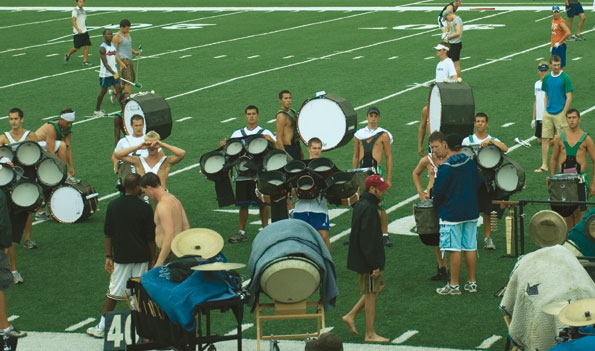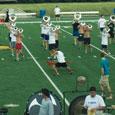
In three years of marching in a competitive drum corps I learned the importance of intensity and efficiency on the marching field. Even though I had marched in a large high school band in Missouri and also in a fine college band, I was amazed at how hard the corps worked while eliminating any distractions to the goal. I learned that an outstanding corps is a complex mechanism that combines logistics, music, leadership, drill, and movement. Although school bands do not have the rehearsal time available to reach the same level of precision, many drum corps lessons can apply to any marching group.
Because our corps performed one show we could focus on reaching a single goal for an entire season. To save time we never practiced attention, drill downs, and parades. We painted our dots on the field and even e-mailed our drill before camp. A school band that has several field shows during the year will have different goals.
Drum corps have the luxury of 1,000 hours a season to practice in multiple 4-hour blocks a day. Physical training is a large part of the program. For school groups the key is improvement during rehearsals, not the number of hours spent on the field. More hours and a louder voice do not always lead to a better performance.
Teaching Everybody
I have met students who have played in some powerhouse bands with strong traditions but who still learned little about marching. These players became skilled at following instructions but did not know how to make decisions on the field. With a large program and plenty of staff, it works fine to have instructors fix every mistake. However, a band of 100 students with a 10-minute show at an average of 120 beats per minute has 120,000 steps to execute even without adding the music. No army of techs can fix problems better than a well-educated group that understands the sport of marching.
My drum corps taught marching techniques that could be applied to various situations rather than simply teaching the steps for the show. A more general instruction, such as explaining how to make a left direction change at a tempo up to 160, can help students become more self-reliant on the field. Focusing on good marching fundamentals takes more time at the start of the year but will allow students to teach themselves the shows later. This is similar to the approach in concert band of teaching musical concepts through selected repertoire rather than focusing on each note in a tune.
The Show
Over a period of four years students develop a vocabulary of such movements as jazz running, ballet positions, backwards marching, and slides. I believe it is helpful to build shows around a single technique each year and then use a different one the following year. You could even design a show based on back handsprings. Once the desired movements for the year have been selected, work on that technique every day. The show should have a clearly understandable theme with every impact reflecting the theme.
Many directors have been trained using geometric, symmetrical drill (flanks, pivots, and gates) but many groups are marching shows with curvilinear drill (curves and lines). The are several distinct differences between the two styles. Geometric design produces a series of pictures; the sets are symmetrical; direction changes are 180, 90, or 45 degrees; and the horns and feet are towards the sideline. Curvilinear sets are asymmetrical with a series of movements, direction changes at random angles, and the horns and feel rarely parallel. Certainly there are exceptions to these characteristics.
One of the biggest differences be-tween the two styles is in what each student sees. Many sets in a geometric show are dressed to the lines parallel and perpendicular to the sideline. As students look toward the major they are often covered down and either four or eight steps from the student in front of them.
Students in a curvilinear set may see students in ten different horizontal relationships between them and the major and still not have anyone to cover down. Some members might spend the whole show exposed to the front sideline. The concepts of dressing and covering down are different. A squiggle set may require students to dress and cover down to the half step and navigate surprisingly complex relationships between performers and lines on the field.
Squiggles are not artistically superior but do draw on different skills. Players are more independent of each other and march at all types of crazy angles. In this instance marching is not just moving the feet correctly but reading the field and predicting how other performers will move. This kind of drill will affect how and what is rehearsed.
Rehearsal
Every director will develop a different approach to rehearsing. I have discovered a few rules that help in keeping players engaged.
Horns cannot be up the whole time. If the standard is that horns are always up but the reality is that they never are, this is no standard at all. Directors like horns up because students talk less although I find that they also listen less; I know this was true for me. Consider a closed-foot parade rest, where the drill sets are readable but the student can relax enough to listen to instructions and save energy.
Do not teach more than ten sets in a day. In the eleven drill camps I have participated in, the drill sets tacked onto the end of a rehearsal have always been the dirtiest at the end of the season. Teach until students cannot learn anymore and then clean what was taught. Run through the drill in multiple ways: singing, buzzing, playing, or while blindfolded. Less progress is made when you have to teach material covered in earlier sessions.
Combine moving and playing as often as possible. The great groups hardly ever play without moving. A marching show is movement with music, and rehearsals should focus on both aspects equally.
Movement
I learned in drum corps to use only the muscles needed but to work these muscles hard. Too many students march with their knees and ankles and hold their horns with their necks. A better approach big muscles even if it hurts more than using joints and tendons. Players should march using glutes and hamstrings and support the horns with shoulders. These muscles can take the stress of marching and playing over time with less risk of injury. Some players will tense their neck or use the wrist and thumb to support the instrument and think they are trying hard. Ultimately, these methods waste energy and damage the body.
When marching it takes the most energy to start and stop. One trick is to pick the weight up, keep it on the balls of the feet as a dancer might, and never set it back down, even when resting. Each exchange from the heels to the balls of the feel costs energy. This is often referred to as keeping the weight forward. Even the solution for keeping the abs engaged and the chest forward is to move the torso as a unit and keep it from absorbing energy.
Building and teaching a system for marching takes an early investment of energy as patterns are learned and muscles are developed. An efficient system applied with great focus and intensity will pay great dividends for years to come. By taking the guesswork out of rehearsal and marching techniques, your group will accomplish even more out on the field.





